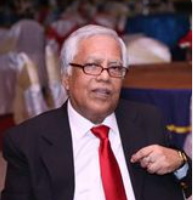Conventional Bangla poetry has remained enshrouded in the ‘superstition of modernity’ propounded mainly by our purported ‘educated’ urbanized class. The ostensible educational system and its associated pride has paved the way for creating the mental barrier which led to the alleged divide of the history of our literature and culture which attach more value to a partial section assuming it to be the significant totality In fact, we have accepted mainstream literature as the one created by the English-educated urban middle class. Although ninety per cent of the people of the country delightfully consume the literary pursuits of the professionals and the poets who emerged from an agro-based greater rural Bangladesh, the so-called high-brow city-dwellers, regretfully, rejected their creative literature. Then some questions come up: are the agro-dependent majority and, likewise, professionals of the greater part of the country living outside the time and period of the typical modernity of the urban-populated section of the country? Even though these mystic poets belong to the same modern period, are they still encapsulated in the ideas and thoughts of the Middle Ages? Have they then created their own modernity? When the urban middle class is creating modern literature following the European trend, has the literary stream of the rural people come to a standstill? If it hasn’t, then what is the trend the mystic poets have been following during that period?
To the utter dismay of the self-proclaimed urban intellectual elitists, created and nurtured by the colonial power, the wisdom and intellectuality of the larger section of the people of the country, has kept on flowing unabated, and to date it is marching ahead with full force. It will be sheer foolishness to consider the unlettered or near-unlettered rural majority as ‘uneducated’. Rather, on many occasions, it has been found that the efforts to underestimate the intellectuality of this silent majority are false, fabricated and baseless. In no way are they the lesser intellectual ones compared to the modern and urban ‘educated’ class.
Not only did the rural creative geniuses absorb the traditional modernism but also inspired and influenced others to follow what they thought was classical modernism. Among the 23 poets, like Lui pa, Kanha pa, of Charyapada (generally the 18-20 line poem written in couplets) and Soroho pa of doha (longer poems), encompassed fierce modernism. The more the ‘establishment’ became anti-people, the more the poets of the common people took their stand in favor of the rights of the people, and their works echoed the sentiments and emotions of ordinary people.
According to the views of the then ‘educated’ Bangalis, Bangla of the pre-colonial period was coarse, unsophisticated and rustic, and to tide over the inheritance of all forms of rusticity, they simply desired to become sharp, classy and intellectually informed. Unfortunately, in the end, they turned out to be uprooted cosmopolitans. Some sensitive and insightful metropolitans, however, fell victim to the painful reclusion, and, to damp down the agonizing estrangement, they finally took a U-turn in search of the national heritage to revivify fading history, brushing aside the pride of urbanity, modernity and snobbery.
In the last twenty years of the 19th century, educated, urban Bangalis started having a close look at and taking interest in the works of the rural poets, better known as Pallikobi. Even a modern poet like Tagore was amazed by the incisive intellectuality, philosophy, classical modernism and artistic excellence found in the creations of the poets, popularly known as ‘Bauls.’ Nonetheless, they continued to remain sidelined as ‘folk’ poets having no ‘seat at the dinner table’ of the supposed enlightenment of the urban poets. Instead of marginalizing them, they should rather be termed as ‘the poets of the real mainstream Bangla literature.’
From Lalon Shah to VobaPagla, for example, from the end of the eighteenth century to the end of the twentieth century, whatever number of urban poets came into being, the poets of the common people outnumbered the urban ones and remained far more active in the larger community of people. It is not that they were the majority only; their works were endowed with a diversity of ideas, and the variety was not only in the style and structure but also in their thoughts. Their poems/songs not only embody different metaphors and images but also have narrative and lyrical qualities. Some of their works are enriched with dramatic qualities; some are theology-ridden; some wander like lovers in the land of imagination; some project cruel realities. Some of those poets have made forays into fairy tales and history; some are entrenched in the problems, crises, and possibilities of their own contemporary society. The contents and thoughts of these poets/singers appeal to ordinary people.
Ram Mohan and his disciples and followers did much to spread free thinking in the urban life of Bengal. Baul poets/singers, on the other hand, continued to oppose the fundamentalist religious consciousness and views, giving short shrift to the fiendish indignation of the Mollahs and Hindu priests. There is no denying that this rebellious element of the culture of the common people of real Bengal triggered the current wave of free thinking in the minds of the uninteresting and tedious life of the rural people.
The heroes of the renaissance of Bengal observed ‘the equality of all people’ from the point of view of bourgeoisie humanism, imported from the West, while Lalon-Duddu-Pagla Kanai, the poets of the larger section of rural commoners, took the ‘lesson of humanism’ from all the secular ideas of traditional Bengal – nanan boron gavirevai, eki boron dudh/jogotvromiadekhlamekimayerpoot (cows of different colours; yet milk is of the same color/going round the world I found the same mother-son bond everywhere).
When Lalon acerbically ridicules the idea of one’s becoming a Muslim through circumcision and a Brahmin by wearing a sacred thread as credentials, doesn’t he sound more radical than western-educated modern urban Bangalis? Certainly, he does.


























0 Comments